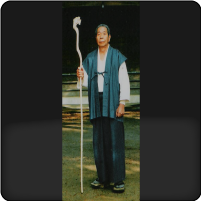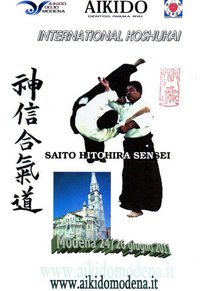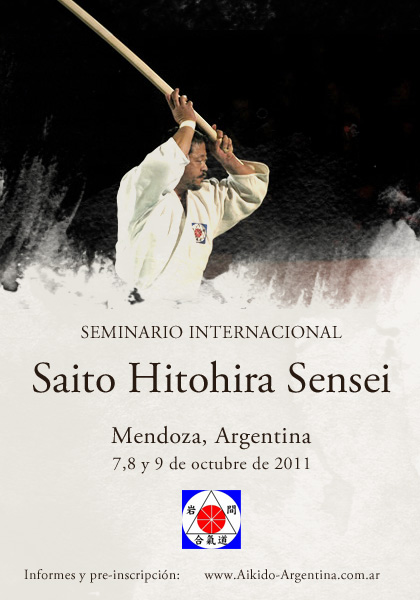
Complete kyu training System
10th KYU
Taijutsu
Tai no henko, ki no nagare, morote dori kokyuho. (Until 3rd kyu the student must also be uke).
Suwari waza kokyu dosa. Appropriate Reigi.
Bukiwaza
(Demonstrated facing the partner) Ken no kamae: chûdan, seigan, jôdan, hasso, waki.
Migi hanmi ken no kamae, hidari hanmi, ai hanmi, gyaku hanmi, hito-e-mi.
Jo no kamae: hidari hanmi, migi hanmi.
9th KYU
Taijutsu
Tai no henko, ki no nagare, morote dori kokyuho. (Until 3rd kyu the student must also be Uke).
Mae/ushiro ukemi, ukemi over one and two persons, yoko ukemi, tobu ukemi de koshi nage, tobu ukemi over one person, shikko (mae and ushiro).
Suwari waza kokyu dosa. Appropriate Reigi.
Bukiwaza
(Demonstrated facing the partner) Ken no kamae: chûdan, seigan, jôdan, hasso, waki.
Migi hanmi ken no kamae, hidari hanmi, ai hanmi, gyaku hanmi, hito-e-mi.
Jo no kamae: hidari hanmi, migi hanmi.
Demonstrate the tanren-uchi exercice with ichi no suburi.
8th KYU
Taijutsu
Tai no henko, ki no nagare, morote dori kokyuho. (Until 3rd kyu the student must also be Uke).
Mae/ushiro ukemi, ukemi over one and two persons, yoko ukemi, tobu ukemi de koshi nage, tobu ukemi over one person, shikko (mae and ushiro).
Suwari waza and tachi waza shomen uchi ikkyo omote/ura, irimi nage.
Suwari waza kokyu dosa. Appropriate Reigi.
Bukiwaza
(Demonstrated facing the partner)Ken no kamae: chûdan, jôdan, hasso, waki.
Migi hanmi ken no kamae, hidari hanmi, ai hanmi, gyaku hanmi, hito-e-mi.
Jo no kamae: hidari hanmi, migi hanmi.
Demonstrate the tanren-uchi exercice with ichi no suburi.
Aiki ken no suburi: 1, 2
Aiki jo no suburi: 1, 2
7th KYU
Taijutsu
Tai no henko, ki no nagare, morote dori kokyuho. (Until 3rd kyu the student must also be Uke).
Mae/ushiro ukemi, ukemi over one and two persons, yoko ukemi, tobu ukemi de koshi nage, tobu ukemi over one person, shikko (mae and ushiro).
Shikko sabaki 1, 2.
Suwari waza and tachi waza shomen uchi ikkyo omote/ura, shomen uchi nikyo omote/ura, irimi nage, kote gaeshi.
First part of the atemi waza kata: zu waza and te waza.
Suwari waza kokyu dosa. Appropriate Reigi.
Bukiwaza
(Demonstrated facing the partner)Ken no kamae: chûdan, seigan, jôdan, hasso, waki.
Migi hanmi ken no kamae, hidari hanmi, ai hanmi, gyaku hanmi, hito-e-mi.
Jo no kamae: hidari hanmi, migi hanmi.
Demonstrate the tanren-uchi exercice with ichi no suburi.
Aiki ken no suburi: 1, 2, 3
Aiki jo no suburi: 1, 2, 3
6th KYU
Taijutsu
Tai no henko, ki no nagare, morote dori kokyuho. (Until 3rd kyu the student must also be uke).
Mae/ushiro ukemi, ukemi over one and two persons, yoko ukemi, tobu ukemi de koshi nage, tobu ukemi over one person, shikko (mae and ushiro).
Shikko sabaki 1, 2.
Suwari waza and tachi waza shomen uchi ikkyo omote/ura, nikyo omote/ura, sankyo omote/ura, and yonkyo omote/ura, irimi nage, kote gaeshi.
First part of the atemi waza kata: zu waza and te waza.
Second part of the atemi waza kata: empi uchi waza and hiza geri waza.
Demonstrate and name: 4 attacks from the front and 4 from behind.
Suwari waza kokyu dosa. Appropriate Reigi.
Bukiwaza
(Demonstrated facing the partner)Ken no kamae: chûdan, seigan, jôdan, hasso, waki.
Migi hanmi ken no kamae, hidari hanmi, ai hanmi, gyaku hanmi, hito-e-mi.
Jo no kamae: hidari hanmi, migi hanmi.
Demonstrate tanren-uchi exercice with ichi no suburi, yon no suburi and o go no suburi.
Aiki ken no suburi: 1, 2, 3, 4, 5
Aiki jo no suburi: 1, 2, 3, 4, 5, 6
Written Essay
A short essay of 1 page with the name of O'Sensei, his successors and the Iwama Ryu Soke(s).
Must also indicate where the art of Aikido was born, and who taught there until 2004.
Must know the name of the organization created to uphold and propagate the Founder's and Morihiro Saito’s Aikido.
5th KYU
Taijutsu
Tai no henko, ki no nagare, morote dori kokyuho. (Until 3rd kyu the student must also be Uke).
Mae/ushiro ukemi, ukemi over one and two persons, yoko ukemi, tobu ukemi de koshi nage, tobu ukemi over one person, shikko (mae and ushiro).
Shikko sabaki 1, 2.
Suwari waza and tachi waza shomen uchi ikkyo omote/ura, nikyo omote/ura, sankyo omote/ura, and
yonkyo omote/ura, irimi nage, kote gaeshi, katatedori ikkyo omote/ura.
Katate dori shiho nage omote/ura.
Atemi waza kata: zu waza, te waza, empiuchi waza, hizageri waza, keri waza.
Demonstrate and name: 4 attacks from the front and 4 from behind.
Suwari waza kokyu dosa. Appropriate Reigi.
Bukiwaza
(Demonstrated facing the partner)Ken no kamae: chûdan, seigan, jôdan, hasso, waki.
Migi hanmi ken no kamae, hidari hanmi, ai hanmi, gyaku hanmi, hito-e-mi.
Jo no kamae: hidari hanmi, migi hanmi.
Demonstrate the tanren-uchi exercice with the following suburi: ichi, ni, san, yon and go, with a partner.
Aiki ken suburi nanahon.
Aiki jo no suburi: 1, 2, 3, 4, 5, 6
Roku no jo.
Written Essay
In one page, name and define 30 words related with aikido.
4th KYU
Taijutsu
Tai no henko, ki no nagare, morote dori kokyuho. (Until 3rd kyu the student must also be Uke).
Suwari waza and tachi waza shomen uchi ikkyo omote/ura, nikyo omote/ura, sankyo omote/ura, and yonkyo omote/ura, irimi nage, kote gaeshi;
katate dori y kata dori ikkyo and nikyo omote/ura, katate dori irimi nage joudan.
Katate dori shiho nage omote/ura.
Katate dori irimi nage joudan.
Muna dori kote gaeshi.
Atemi waza kata: zu waza, te waza, empiuchi waza, hizageri waza, keri waza.
Demonstrate and name: 4 attacks from the front and 4 from behind.
Suwari waza kokyu dosa. Appropriate Reigi.
Bukiwaza
Aiki ken suburi nanahon
Demonstrate the tanren-uchi exercice with the following suburi: ichi, ni, san, yon, go, with a partner.
Aiki jo no suburi: 1, 2, 3, 4, 5, 6
Roku no jo.
Sanjuuichi no kata.
Jo dori kokyu ho, shiho nage omote/ura.
3rd KYU
Taijutsu
Tai no henko, ki no nagare, morote dori kokyuho. (Until 3rd kyu the student must also be Uke).
Tachi waza shomen uchi, ikkyo~sankyo omote/ura.
Ryote dori, yokomen uchi dori shiho nage omote/ura (when applicable).
Tsuki, shomen uchi kote gaeshi.
Yokomen uchi irimi nage em kihon and ki no nagare.
Katate dori kaiten nage soto/uchi mawari.
Be prepared for jyu waza with one partner attacking with men, muna and gedan tsuki.
Suwari waza kokyu dosa. Appropriate Reigi.
Bukiwaza
Aiki ken suburi nanahon.
Go no awase, shichi no awase.
Tachi dori sankyo, yonkyo, koshi nage.
Demonstrate the tanren-uchi exercice with the following suburi: ichi, ni, san, yon, go, with a partner.
Aiki jo no suburi: tsuki waza, menuchi waza
Roku no jo, go no jo, yon no jo, san no jo.
Hachi no jo.
Sanjuuichi no kata.
Jo dori: kokyu ho, shiho nage omote/ura.
Shurikenjutsu
Etiquette and breathing, preparation. Manji no kata. Throw 5 shuriken from the learning distance and from the first distance.
Written Essay
A one page composition about the history of aikido.
2nd KYU
Taijutsu
Tai no henko, ki no nagare, morote dori kokyuho.
Tachi waza shomen uchi, ikkyo~yonkyo omote/ura.
Shiho nage omote/ura (when applicable), nishu.
Yokomen uchi kote gaeshi.
Katate dori irimi nage joudan, chuudan and gedan.
Kaiten nage oyo waza (free technique).
Other techniques that the teacher may ask.
Be prepared for jyu waza against shomen uchi attack.
Suwari waza kokyu dosa. Appropriate Reigi.
Bukiwaza
Aiki ken suburi nanahon.
Go no awase, shichi no awase.
Demonstrate tanren-uchi exercice with the following suburi: ichi, ni, san, yon, go, with a partner.
Tachi dori sankyo, yonkyo, koshi nage.
Aiki jo suburi tsuki waza gohon, menuchi waza gohon, katate waza sanbon.
Roku no jo, go no jo, yon no jo, san no jo, ni no jo, ichi no jo.
Hachi no jo.
Sanjuuichi no kata.
Juusan no kata.
Jo dori: kokyu ho, shiho nage omote/ura.
Shurikenjutsu
Etiquette and breathing, preparation. Manji no kata. 5 shuriken from learning distance to second distance.
Written Essay
"The importance of Martial Arts."
Write the names and descriptions of the Aikiken and Aikijo suburi.
1st KYU
Taijutsu
Suwari waza/tachi waza: yokomen uchi ikkyo~gokyo omote/ura.
Two techniques (nishu) of: hanmi han dachi, shiho nage, kote gaeshi, kokyu nage, irimi nage, koshi nage, ushiro waza.
Jyuu waza against 2 partners.
Demonstrate the correct folding of the hakama and the dogi.
Bukiwaza
Ken suburi nanahon.
Shihogiri.
Shihotsuki.
Jo suburi.
Sanjuuichi no kata.
Juusan no kata.
Tanto dori, tachi dori e jo dori: ni shu
Shurikenjutsu
Etiquette and breathing, preparation. Manji no kata. 5 shuriken from learning distance to third distance.
Trabalho Escrito
Write the following kanji: days of the week and numbers from 1 to 10
Write a short composition about a martial art.
Give an oral explanation of the duties of a Traditional Aikido practitioner.
Explain orally what is the proper etiquette inside and outside a dojo for an aikidoka.
Children and youths
Until 11 years of age, the examination will consist only of suwari waza techniques.
From 11 years of age they will have to do the examination both in tachi waza and suwari waza.
From 14 years of age, they will also start to do atemi waza techniques.
With a written permission from the parents, youths from 15 to 18 years of age will also present shuriken techniques when required.
Weapons’ techniques will have to be shown in every examination and by all ages.
Written examinations are also compulsory for any age.




















